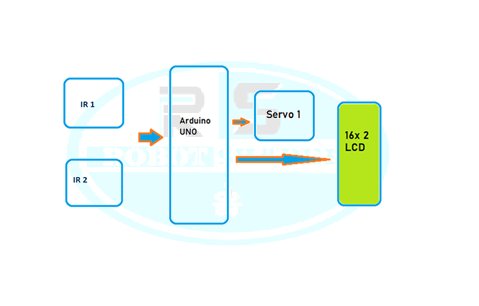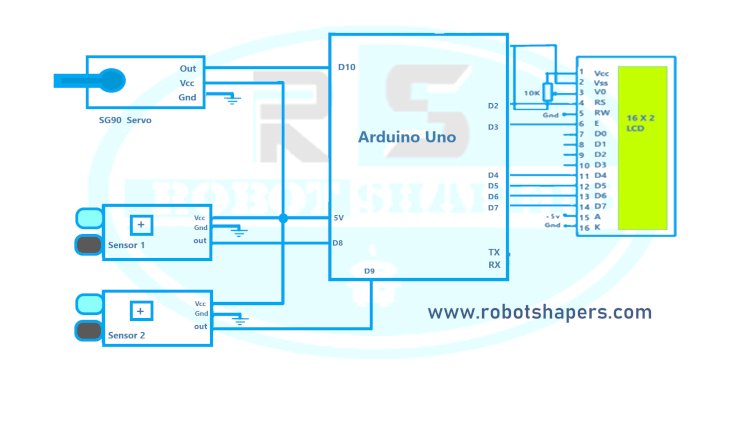Arduino Parking System
Step into the automated world of parking with Robotshapers' groundbreaking "Parking Parking System." Our innovative solution revolutionizes the way cars enter and exit parking lots, offering seamless recognition and display of available spaces. With customizable capacity settings and advanced microcontroller technology, accidents due to overcrowding are a thing of the past.

We present the concept of automatic parking in the "Automatic Parking System" project. In today's world where everything is automated, we have created a system that automatically recognizes car entrance and exit from the door and then shows the cars in the parking lot. We can set the maximum capacity of the vehicle with the help of the user interface provided in the form of hardware changes to avoid accidents. We use a microcontroller that recognizes the movement of the car and decides whether there is enough space for the car to enter the space. The door can also be opened when the vehicle enters the parking lot or closed when the vehicle leaves the parking lot.
Understanding of vehicle inputs and outputs is done with the help of infrared transmitters and receivers. The infrared transmitter is mounted on one side in front of the door and the receiver is located directly in front of the transmitter opposite the door. When a car approaches and the infrared beam is blocked by the car, the receiver has no infrared and its output changes management.
Components required:
Layout of the system:

Circuit diagram:

Code:
#include
// LCD module connections
LiquidCrystal lcd(2,3,4,5,6,7);
// IR sensor pin definitions
const int sensor1Pin = 8;
const int sensor2Pin = 9;
// Servo motor pin
const int servoPin = 10;
// Threshold values for sensor detection
const int obstacleThreshold = 500; // Adjust this value based on sensor readings
void setup() {
lcd.begin(16, 2);
lcd.print("Parking System");
pinMode(sensor1Pin, INPUT);
pinMode(sensor2Pin, INPUT);
pinMode(servoPin, OUTPUT);
// Initialize servo position (90 degrees)
digitalWrite(servoPin, HIGH);
delayMicroseconds(1500);
digitalWrite(servoPin, LOW);
}
void loop() {
int sensor1Value = analogRead(sensor1Pin);
int sensor2Value = analogRead(sensor2Pin);
lcd.setCursor(0, 1);
lcd.print("S1: ");
lcd.print(sensor1Value);
lcd.print(" S2: ");
lcd.print(sensor2Value);
if (sensor1Value < obstacleThreshold && sensor2Value < obstacleThreshold) {
// Both sensors detect an obstacle
lcd.setCursor(0, 0);
lcd.print("No Parking Space");
parkCar();
} else {
// At least one sensor does not detect an obstacle
lcd.setCursor(0, 0);
lcd.print("Parking Available");
retractServo();
}
delay(500);
}
void parkCar() {
// Move the servo to block the parking space
digitalWrite(servoPin, HIGH);
delayMicroseconds(1000);
digitalWrite(servoPin, LOW);
delay(2000);
}
void retractServo() {
// Move the servo to retract and clear the parking space
digitalWrite(servoPin, HIGH);
delayMicroseconds(2000);
digitalWrite(servoPin, LOW);
delay(2000);
}
Applications:
- Urban parking: In congested cities, automated parking maximizes space utilization and reduces congestion by parking vehicles efficiently and keeping vehicles in tight spaces.
- Business Buildings: Offices, shopping malls and airports use these systems to optimize parking and improve visitor traffic.
- Residential buildings: Apartment complexes and condominiums use automated parking systems to save space and provide residents with convenient parking.
- Hotels: Automatic parking systems enhance the experience of hotel guests by offering efficient and safe parking options.
- Hospitals: Hospitals use this system to efficiently manage patient and visitor parking and provide easy access at critical times.
- Airports: Automated systems are used to reduce waiting times while accommodating more vehicles in airport car parks.
- Public Transport Stations: Train stations and bus stations use these systems to create a comfortable environment for passengers.
- Event Venues: Stadiums and arenas use automated parking systems to handle large crowds during events.
Best projects in Bhilai, Chhattisgarh, India. Contact: 7067150002

 robotshapers1
robotshapers1 


















